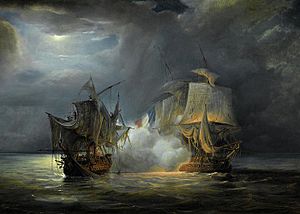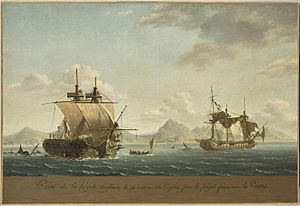Action of 18 September 1810 facts for kids
Quick facts for kids Action of 18 September 1810 |
|||||||
|---|---|---|---|---|---|---|---|
| Part of the Napoleonic Wars | |||||||
 Ceylon and Vénus, Pierre Julien Gilbert, 1835 |
|||||||
|
|||||||
| Belligerents | |||||||
| Commanders and leaders | |||||||
| Charles Gordon Josias Rowley |
Jacques Hamelin |
||||||
| Strength | |||||||
| frigate HMS Ceylon, later reinforced by HMS Boadicea | frigate Vénus and corvette Victor | ||||||
| Casualties and losses | |||||||
| 10 killed 33 wounded |
Vénus and crew captured 9 killed 15 wounded |
||||||
The Action of 18 September 1810 was a sea battle during the Napoleonic Wars. It took place in the Indian Ocean between British and French warships. This battle was part of a larger fight for control of the French island base of Île de France. French ships used this island to attack British trade routes.
This action happened right after the Battle of Grand Port, where Britain lost four frigates. Just four days earlier, another British frigate was captured and then quickly taken back. Because the British navy had lost so many ships, new ones were sent to the area. These new ships became targets for the larger French fleet.
HMS Ceylon was sent from Madras (India) to help the British fleet. While searching for Commodore Josias Rowley near Île de France, Ceylon was spotted by French Commodore Jacques Hamelin. Hamelin chased Ceylon in his ship, Vénus, with help from a smaller ship called a corvette.
Vénus was faster than Ceylon. Captain Charles Gordon on Ceylon almost reached the safety of Île Bourbon. But he was caught and forced to fight the French ship during the night. Both ships were badly damaged. Captain Gordon, who was wounded, surrendered to the approaching corvette.
When morning came, Rowley's ship, HMS Boadicea, arrived. It recaptured Ceylon, chased away the corvette, and forced the damaged French flagship Vénus to surrender. Commodore Hamelin was captured. This was the last ship-to-ship battle in the area before the British successfully invaded Île de France in December 1810. Without Hamelin, the French fleet, low on supplies and morale, did not try to stop the invasion.
Contents
Why the Battle Happened
The French islands of Île de France and Île Bonaparte in the Indian Ocean were great places for French ships to attack British trade routes. These routes carried valuable goods from Britain to India. From 1808, a strong French fleet of four frigates, led by Commodore Jacques Hamelin, operated from these islands.
In 1809 and early 1810, these French ships freely attacked British trade. They captured many valuable merchant ships and some smaller warships. To stop this, British Admiral Albemarle Bertie sent a small group of warships to blockade the islands. This group was led by Commodore Josias Rowley. Rowley knew it would be hard to find and defeat the French ships in the vast ocean. But he could limit their power by attacking their bases. He raided Saint Paul harbour in 1809 and captured Île Bonaparte in 1810, renaming it Île Bourbon.
The Battle of Grand Port and Its Impact
In August 1810, four of Rowley's frigates, most of his fleet, went to Île de France. They were meant to blockade Grand Port. On August 20, a French fleet arrived, led by Captain Guy-Victor Duperré. This made the British Captain Samuel Pym order an attack on the harbour on August 23. The attack was not well planned. Two British ships were wrecked on the reefs protecting the harbour entrance. Pym could not pull back his remaining ships, and his entire fleet was lost.
This left Rowley with only his flagship, HMS Boadicea, and two small brigs. He was now fighting six large French frigates. Urgent help was requested. Meanwhile, French ships under Captain Pierre Bouvet blockaded Île Bourbon.
Arrival of Reinforcements
The first ship to arrive was HMS Africaine, commanded by Captain Robert Corbet. On September 13, 1810, Corbet fought Bouvet's two frigates alone. He was defeated and died from his wounds shortly after. Rowley in Boadicea was able to recapture Africaine later that day. But the ship was badly damaged and could not help the British fleet. Bouvet went back to Grand Port for repairs.
So, Bouvet was not on blockade duty on September 17 when HMS Ceylon arrived. Ceylon was an unusual ship. It was built by the Honourable East India Company (HEIC) in Bombay as a merchant ship. But it was designed to act as a 32-gun frigate during wartime. In 1805, the British government bought it for the Royal Navy.
In 1810, Captain Charles Gordon commanded Ceylon. He was ordered to help Rowley after news of the losses at Grand Port reached Madras. In his rush, Gordon could not get any Royal Marines. Instead, 100 soldiers from the 69th Regiment and the 86th Regiment joined the ship. General John Abercromby and his staff were also on board. They were meant to lead a planned attack on Île de France.
The Chase Begins
Captain Gordon arrived near Port Napoleon on September 17. He hoped to find Rowley blockading the port with Boadicea. However, Rowley was near Île Bourbon, fighting Bouvet's frigates. So, Gordon only found Hamelin's fleet in the harbour. This fleet included the frigates Vénus and Manche, plus the corvette Victor.
Gordon realized he was greatly outnumbered. He sailed west towards Île Bourbon to meet Rowley. He wanted to tell Rowley where Hamelin's fleet was. French lookouts on shore saw Ceylon. But they thought she was a troopship because of her unusual design. This news quickly reached Hamelin, who immediately chased Ceylon with Vénus and Victor.
At 2:00 PM, Ceylon saw Hamelin's ships chasing them. The crew worked harder to escape. They thought Victor, which had three masts, was a larger ship. This made them believe they were even more outnumbered. As night fell, Gordon slowed Ceylon. He hoped to fight Vénus alone, as it had pulled ahead of Victor. But the French flagship also slowed down for the corvette to catch up. So Gordon sped up again, leading Hamelin southwest towards Île Bourbon.
The Battle
At 12:15 AM on September 18, Vénus caught up with Ceylon. Ceylon began firing at the larger French frigate as it passed. Hamelin knew his ship was bigger and had more powerful guns. He did not wait for Victor. He attacked right away, passing Ceylon and turning to fire along its front (a raking fire).
For an hour, the ships fired at each other. At 1:15 AM, Hamelin realized he was fighting a warship, not a troopship. He pulled back to fix damage to his ship's ropes and sails. Ceylon was more badly damaged than the French ship. When Hamelin returned at 2:15 AM, Ceylon's repairs were not finished, so it could not escape.
The battle started again. Both frigates suffered serious damage in this second fight. By 3:00 AM, Vénus had lost its mizzenmast (the mast at the back) and two topmasts. Ceylon had lost all of its topmasts, which had destroyed much of the ship's rigging as they fell. With both ships unable to move well, the fight continued close up until 4:00 AM. Then, Vénus was able to pull away to wait for Victor to arrive.
The French corvette Victor had struggled to catch up during the night. It did not arrive until dawn. When it did, it saw the flagship Vénus damaged and the British ship Ceylon even worse. Victor sailed directly at Ceylon. It moved around the frigate and got into a raking position. From here, its cannon could cause heavy damage and injuries to Ceylon without being fired upon. Rather than have his ship destroyed, the wounded Captain Gordon surrendered. Victor's crew boarded Ceylon. Gordon and his officers, including General Abercromby, were taken to Vénus as prisoners of war.
Rowley's Arrival
As dawn broke and it became clearer, the sailors on Ceylon, Vénus, and Victor realized they were close to Saint Denis on Île Bourbon. This meant they could be attacked by Rowley's flagship, Boadicea. Despite quick repairs, neither Ceylon nor Vénus could sail well by 7:30 AM. At that time, British lookouts on the island spotted the three ships and sent word to Rowley.
Within ten minutes, Rowley was at sea. He took 50 volunteers from Africaine to add to his crew. Hamelin tried desperately to get back to Île de France. He ordered Victor to tow Ceylon. But progress was slow, and strong winds kept breaking the tow rope. The winds did not help the dismasted Ceylon and Vénus.
During the day, Boadicea kept getting closer. At 3:30 PM, Victor was forced to leave Ceylon and sail to help Vénus. As soon as the French prize crew left, Lieutenant Philip Fitz Gibbon, the remaining officer on Ceylon, raised the British flag again. He took control of the ship. This allowed Boadicea to sail past the recaptured frigate and directly attack the French ships. It reached Vénus at 4:40 PM.
Hamelin knew his damaged flagship could not properly defend against Rowley's attack. He ordered Victor to take news of his defeat back to Port Napoleon. Hamelin prepared his ship for a small fight. He fired at Boadicea as it approached. But he was forced to surrender within ten minutes.
Aftermath
With help from HMS Otter, which had followed Boadicea from Saint Denis, Rowley brought his captured ship and the damaged Ceylon back to Île Bourbon. British casualties were relatively low for such a tough battle. Ceylon had 10 men killed and 31 wounded. Boadicea had only 2 wounded. French losses were also light, with 9 dead and 15 wounded on Vénus. Victor had no casualties.
Rowley repaired Ceylon and gave command back to Gordon. Vénus was also repaired and joined the British navy as HMS Nereide. This replaced the Nereide that was lost at Grand Port. Many years later, this battle was one of the actions recognized by special awards. These awards were given to British participants still alive in 1847.
With the British fleet stronger and the French commander and best frigate captured, the fighting stopped. The French could no longer repair their ships because they lacked supplies on Île de France. So they stayed in port and prepared for the coming invasion. Rowley was busy getting troops, supplies, and his fleet ready for the attack. Admiral Bertie led this attack in November 1810. The French fleet did not try to stop the invasion and was captured in their harbours. Bertie was praised for defeating Île de France and was made a baronet for his successful campaign. He sent Rowley back to Britain with the news.
A court martial (a military trial) was held on HMS Illustrious after the invasion. It cleared Gordon of any blame for his ship's defeat. However, historian William James criticized Gordon for thinking Victor was a frigate instead of a smaller corvette. He also found differences between Gordon's public story and the ship's official log.
See Also
Images for kids



